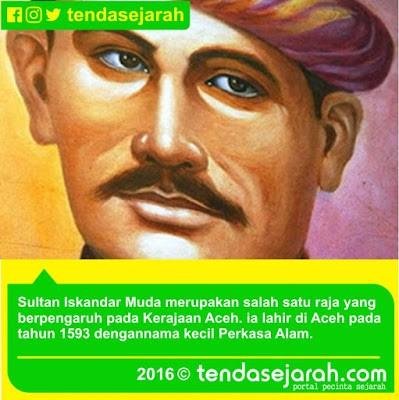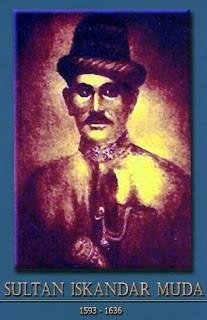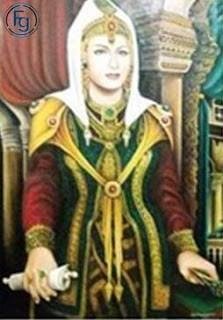History of the Life of Sultan Iskandar Muda
Sultan Iskandar Muda was the most influential King of the Kingdom of Aceh. He was born in Aceh in 1593. His first name is Mighty Nature. On the mother's side, Sultan Iskandar Muda is a descendant of King Darul-Kamal, while on the side of his father he is descended from Raja Makuta Alam, his mother is named Putri Raja Indra Bangsa, or other name Paduka Shah Alam, who is the son of Sultan Alauddin Riayat Syah, Sultan Aceh 10th. Putri Raja Indra Bangsa married Sultan Mansyur Syah, son of Sultan Abdul Jalil (who is the son of Sultan Alauddin Riayat Syah al-Kahhar, the 3rd Sultan of Aceh). So, actually the father and mother of Sultan Iskandar Muda are equally heirs of the kingdom.

Sultan Iskandar Muda married a princess of the Pahang Sultanate, better known as Putroe Phang. From the results of this marriage, Sultan Iskandar Muda blessed with two children, namely Meurah Pupok and Princess Safiah. It is said, because too much love of the Sultan with his wife, Sultan ordered the construction of Gunongan in the middle of the Khayali Field (Taman Istana) as a sign of his love. Reportedly, the princess is always sad because it harbored a very longing homesick hometown. Therefore the Sultan built Gunongan to cure the miss of the princess. Until now Gunongan still can be seen and visited.
The journey of Sultan Iskandar Muda to Johor and Melaka in 1612 stopped at a Tajung (meeting of Asahan and Silau rivers) to meet King Simargolang. Sultan Iskandar Muda eventually married one of the princesses of King Simargolang who later blessed with a son named Abdul Jalil (who was crowned as Sultan Asahan). Sultan Iskandar Muda began to occupy the throne of the Kingdom of Aceh at a fairly young age (14 years). He reigned in the Kingdom of Aceh between 1607 and 1636, or just for 29 years. When he began to assume the title of king became a debate among historians. However, referring to Bustan al-Salatin, he was declared sultan on 6 Dhul-Hijjah 1015 H or around Early April 1607. The reign of Sultan Iskandar Muda is known as the most glorious period in the history of the Kingdom of Aceh Darussalam. He is known to be very skilled in building the Kingdom of Aceh into a kingdom of Strong, Great, and not only respected by other Kingdoms in the archipelago, but also by the outside world. During his reign, the Kingdom of Aceh was included in the Five Greatest Kingdoms in the World. The main step taken by Sultan Iskandar Muda to strengthen the kingdom is to build an army that is generally filled with young soldiers. Sultan Iskandar Muda once conquered Deli, Johor, Bintan, Pahang, Kedah, and Nias from 1612 to 1625. Sultan Iskandar Muda is also very concerned about the order and rules of the royal economy. In the royal territory there is a transit bandar (Kutaraja, now better known as Banda Aceh) which is so strategic that it can connect the royal trade wheel with the outside world, especially the West. Thus, of course the kingdom's economy is very helpful and increased sharply. According to the Aceh tradition, Sultan Iskandar Muda divides the territory of Aceh into an administrative region called Ulèëbalang and Mukim, this is confirmed by the report of a French explorer named Beauliu, that "Iskandar Muda cleared almost all the old nobles and created a new nobleman." Mukim was originally a collection of several villages to support a mosque led by an Imam (Imeum). Ulèëbalang (Hulubalang) was at first perhaps the chief subordinate of the Sultan, who was awarded the Mukim Sultan, to manage as Feodal Owner.

Sultan Iskandar Muda is known to have very good relations with Europe. It is said that he had established good communication with England, Holland, France and Turkey Ustmaniyah. For example, in the 16th century Sultan Iskandar Muda once established a harmonious communication with the British Empire at that time held by Queen Elizabeth I. Through his envoy, Sir James Lancester, Queen Elizabeth I began the contents of a letter delivered to Sultan Iskandar Muda. The following is an excerpt of the contents of Sultan Iskandar Muda's letter, which is still kept by the government to date, dated 1585:
"I am the mighty ruler of the Regions below the wind, Who holds sway over the land of Aceh and over the land of Sumatra and over all the land tributary to Aceh, which stretch from the sunrise to the sunset."
Meaning:
"Slave to the Mighty Sovereigns of the Underworld, gathered upon the Land of Aceh and upon the Land of Sumatra and over all the areas subject to Atjeh, which range from the horizon of the sunrise to the sunset"
During his reign, there were a number of great Scholars. Among these are Syiah Kuala as the great mufti of the Kingdom of Aceh during the time of Sultan Iskandar Muda. The relationship of both is as rulers and scholars who complement each other's journey of governance.
The relationship is likened to "Adat bak Peutoe Meureuhom, Hukom bak Syiah Kuala" (Adat under the authority of Sultan, Life of religious law under the decision of Mr. Syiah Kuala). Sultan Iskandar Muda also strongly trusted other very famous scholars at that time, namely Sheikh Hamzah Fanshuri and Sheikh Syamsuddin As-Sumatrani. Both of these scholars also influenced the Sultan's policy a great deal. The two are the greatest writers in the history of the archipelago.
In addition to the United Kingdom, Prince Maurits - the founder of the Dutch Oranje dynasty also sent a letter with the intention of requesting the Sultanate of Aceh Darussalam. The Sultan welcomed their good intentions by sending his delegation to the Netherlands. The group was led by Tuanku Abdul Hamid.
This group is known as the first Indonesian to stop in the Netherlands. During his visit Tuanku Abdul Hamid became sick and died. He was buried in a large scale in the Netherlands with the presence of the Dutch dignitaries. But because the Dutch had never buried the Muslims, he was buried with the Christian way in the yard of a church. Now in his tomb there is an inscription which was inaugurated by the late Reverend Prince Bernhard the husband of the late Queen Juliana and Her Majesty the Queen Beatrix.
Sultan Iskandar Muda sent his envoy to the Ottoman sultan based in Constantinople. Because at that time the Ottoman Empire was gering then the envoy of the Aceh Kingdom was lingered so long that they had to sell little by little gift offerings for their survival. Then in the end when they were received by the Emperor, their offerings were only Lada Sicupak or Lada sekarung.
But the Emperor welcomed the gift and sent a cannon and some capable men in war science to help the Kingdom of Aceh. The cannon is still there until now known as Meriam Lada Sicupak. In the later period the Ottoman Sultan sent a service star to Sultan Iskandar Muda.

At that time the Kingdom of Aceh also received the visit of the Royal Kingdom envoy. The envoy of the King of France originally intended to present a precious mirror to Sultan Iskandar Muda. But on the way the mirror broke. Finally they dedicate the fragments as a gift to the Emperor. In his book, Denys Lombard says that Sultan Iskandar Muda is very fond of valuable objects.
At that time, the Kingdom of Aceh was the only Malay Kingdom with Balee Ceureumeen or the Glass Hall inside his palace. According to the French Envoy, the Palace of the Sultanate of Aceh is not less than two kilometers. The palace is named Daruddunya Palace (Now Meuligo Aceh, Governor's Residence). It includes Medan Khayali and Medan Khaerani that can accommodate 300 elephants. Sultan Iskandar Muda also ordered to move the flow of the Krueng Aceh River to flow through his palace (the river is still to be seen, flowing calmly around Meuligoe). That's where the Sultan often swims while entertaining his guests.
Sultan Iskandar Muda died in Aceh on December 27, 1636, at a fairly young age of 43 years. Since his son was still alive, the throne of his power was then held by his son-in-law, Sultan Iskandar Thani (1636-1641). After Sultan Iskandar Tani died the throne of the kingdom then held widow Iskandar Tani, namely Sultanah Tajul Alam Syafiatudin Shah or Puteri Safiah (1641-1675), who is also the daughter of Sultan Iskandar Muda.
Sultan Iskandar Muda is a national hero who has been instrumental in the process of forming a very strong character for the archipelago and Indonesia. During his reign, Sultan Iskandar Muda showed his anti-colonialist attitude. He was even very firm against the kingdoms who built relations or cooperation with the Portuguese, as one of the colonists at that time.
Sultan Iskandar Muda has a very firm character in dispelling all forms of colonial domination. For example, the period of 1573-1627 Sultan Iskandar Muda had waged war jihad against the Portuguese 16 times, although all failed because of the enemy fortress. The defeat caused the population to fall drastically, so Sultan Iskandar Muda took a policy to withdraw all occupations in the conquered areas, such as in West Sumatra, Kedah, Pahang, Johor and Melaka, Perak, and Deli, for migration to the core Aceh region.
At the time of the reign, Sultan Iskandar Muda divided the rules of law and state administration into the four areas which then described in practical accordance with the cultural order of the people of Aceh.
First: the field of Law submitted to Shaykh Islam or Qadhi Malikul Adil. Law is the principle of guaranteeing the creation of security and peace. With the law it is expected that this formal regulation can guarantee and protect all the interests of the people.
Second: Indigenous fields submitted to the wisdom of the Sultan and Counselor. This field is a legislative instrument that plays a major role in regulating the state's governance of the dignity of the balang and the kingdom's dignity.
Third: the Resam field which is the Commander's affair. Resam is a rule that has become custom (custom) and implemented through legal and customary instruments. That is, any unknown rules are then determined through a mutual do-together resin.
Fourth: the field of Qanun which is the policy of Maharani Putro Phang as empress of Sultan Iskandar Muda. This aspect has been in effect since the founding of the Kingdom of Aceh.
Sultan Iskandar Muda is known as a very firm king in applying Islamic Shari'a. He even once did Rajam against his own son, named Meurah Pupok for committing adultery with the wife of an officer.
Sultan Iskandar Muda has also issued a policy on the prohibition of usury. It is not strange that now Nanggroe Aceh Darussalam applies Islamic Shari'a because its trace of application has existed since ancient times. Sultan Iskandar Muda is also very fond of Sufism.
Sultan Iskandar Muda had a will to practice the Eight Case, the Sultan of the Wazir, Hulubalang, Pegawai, and Rakyat among them are as follows:
First, to always remember to Allah Ta'ala and fulfill the promise that has been spoken.
Second, lest the Kings insult Alim Ulama and the Wise Expert.
Third, lest the Kings believe what comes from the enemy.
Fourth, the Kings are expected to buy many weapons. The purchase of weapons is intended to increase the strength and defense of the kingdom from possible enemy attacks at any time.
Fifthly, the kings should have the Graceful nature (handed down). Kings are required to pay attention to the fate of their people.
Sixth, the king should run the law based on the Qur'an and the Sunnah of the Prophet.
Seventh, in addition to these two sources, other sources of law that must be held are Qiyas and Ijma '.
Eighth, then hold on to the Law of Kingdom, Tradition, Resam, and Qanun.
The testaments indicate that Sultan Iskandar Muda was a pious, wise and caring leader of the interests of Religion, People and the Kingdom.
Hamka sees the personality of Sultan Iskandar Muda as a pious leader and holds firm to the principles and sharia of Islam. About his leadership personality, Antony Reid saw that Sultan Iskandar Muda was very successful in exercising authoritarian, centralistic, and always expansionist power. The character of the Sultan is much influenced by the nature of his grandfather. The glory and glory of the Kingdom of Aceh at that time did not escape the character of monarchical power because the royal model is different from the concept of democratic modern statehood.
The letter of Sultan Iskandar Muda to King James I King of England, In 1615 was one of his amazing works. The letter (manuscript) is Malay language, filled with beautiful ornaments of flower motifs, the height reaches one meter, and it is said that the letter includes the Largest Letters Throughout History. The letter was written as a form of a strong desire to show the international world how important the Kingdom of Aceh Darussalam as the Main Power in the World.
Through Presidential Decree No. RI. 077 / TK / Year 1993 dated 14 September 1993, Sultan Iskandar Muda was awarded the title of National Hero by the Government of Indonesia and received the honor of Bintang Mahaputra Adipradana (Class II). As a form of pernghargaan against him, the name of Sultan Iskandar Muda immortalized as the name of the street in a number of areas in the country, the name of the Sultan has been Captured as Warship KRI Sultan Iskandar Muda, International Airport Sultan Iskandar Muda and Kodam Iskandar Muda Nanggroe Aceh Darussalam.
Amazing